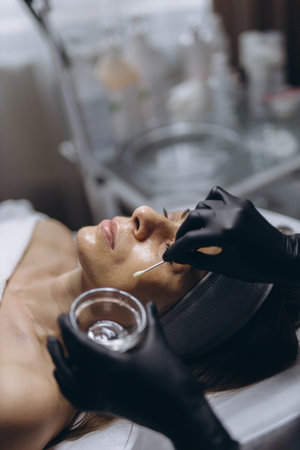Understanding Hyperpigmentation in British Ethnic Skin
Hyperpigmentation is a common skin concern that manifests as dark patches or uneven skin tone, and it can have a distinct impact on individuals from various ethnic backgrounds residing in the UK. British ethnic skin encompasses a diverse spectrum, including those of African, South Asian, Caribbean, Middle Eastern, and East Asian descent. Each of these groups presents unique biological characteristics which influence how hyperpigmentation develops and responds to treatment.
At the core, hyperpigmentation occurs due to an overproduction or irregular distribution of melanin—the pigment responsible for skin colour. Factors such as genetics, hormonal fluctuations, sun exposure (even through the often-cloudy British weather), inflammation, and injury can all trigger this response. For instance, post-inflammatory hyperpigmentation (PIH) is particularly prevalent among darker skin tones, often following acne, eczema, or minor trauma.
Cultural considerations also play a significant role in both the perception and management of hyperpigmentation within British ethnic communities. There may be varying attitudes towards skin tone uniformity and different preferences for cosmetic outcomes. Moreover, traditional remedies or social stigma can influence when and how individuals seek professional advice or opt for over-the-counter solutions.
Understanding these nuances is essential for tailoring effective treatments and guidance. As we navigate the range of non-prescription options available across UK pharmacies and high street retailers, recognising the interplay between biology and culture ensures that recommendations are not only scientifically sound but also culturally sensitive and relevant.
Key Ingredients to Look for in OTC Products
When it comes to managing hyperpigmentation, especially among Britain’s richly diverse population, choosing the right over-the-counter (OTC) products is essential. Individuals with darker skin tones—common within Black, South Asian, and other ethnic communities across the UK—often face unique pigmentation challenges. Scientific research underscores that certain ingredients not only address hyperpigmentation effectively but also suit the sensitivities of ethnic skin. Below, we examine the most effective OTC ingredients, their modes of action, and specific considerations for British ethnic skin types.
Scientifically-Proven Ingredients
The following table outlines the top evidence-backed ingredients found in OTC hyperpigmentation treatments, highlighting their benefits and suitability for darker complexions:
| Ingredient | Main Benefits | Suitability for Ethnic Skin | Common Product Forms |
|---|---|---|---|
| Niacinamide (Vitamin B3) | Reduces melanin production; anti-inflammatory; improves skin barrier function | Highly suitable; gentle and reduces post-inflammatory dark marks common in darker skin | Serums, creams, toners |
| Azelaic Acid | Inhibits tyrosinase (an enzyme involved in melanin production); reduces redness; antibacterial properties | Particularly beneficial for post-inflammatory hyperpigmentation (PIH), often seen after acne or eczema in ethnic skin | Creams, gels |
| Vitamin C (Ascorbic Acid) | Antioxidant; brightens skin tone; inhibits melanin synthesis | Effective for uneven tone but must be stabilised to prevent irritation in sensitive or darker skin types | Serums, lotions |
| Kojic Acid | Blocks melanin formation; lightens existing dark spots | Use with caution; can cause irritation if overused, especially on sensitive or dry ethnic skin types | Creams, serums, soaps |
| Licorice Extract | Reduces pigmentation through glabridin; anti-inflammatory effects soothe irritated skin | Mild and generally safe for regular use on darker complexions prone to inflammation-induced pigmentation | Creams, serums, masks |
What Makes These Ingredients Suitable for British Ethnic Skin?
Darker skin tones tend to be more reactive to trauma and inflammation, leading to a higher risk of persistent dark marks or patches. Ingredients such as niacinamide and azelaic acid are celebrated for their ability to treat discolouration gently without exacerbating sensitivity or causing hypopigmentation (unwanted light spots). Vitamin C remains a staple but should be chosen in stable formulations (like magnesium ascorbyl phosphate) to avoid irritation. Kojic acid and licorice extract are helpful adjuncts but require careful monitoring for any adverse reactions.
Treatment Tip:
For best results—and to avoid worsening pigmentation—it is recommended that individuals with ethnic skin patch-test new products and introduce one active ingredient at a time. Always follow up with broad-spectrum sun protection: even in the UK’s often grey weather, UV exposure can undo progress made by these targeted treatments.
![]()
3. Reading UK Product Labels: What Matters?
When exploring over-the-counter hyperpigmentation solutions in the UK, understanding local labelling conventions is crucial—especially for those with ethnic skin tones seeking safe and effective care. British skincare products sold at high-street pharmacies like Boots and Superdrug adhere to strict regulations, so knowing what to look for on packaging can make a significant difference in your results.
The Essentials of British Labelling
UK product labels are required by law to list all active ingredients in descending order of concentration, making it easier for consumers to spot key agents such as niacinamide, vitamin C, or azelaic acid—ingredients commonly recommended for uneven skin tone. Additionally, you’ll often find “dermatologically tested” or “suitable for sensitive skin” claims; while these aren’t guarantees of efficacy, they suggest a product’s gentleness and suitability for a range of skin types.
Spotting Products for Ethnic Skin
British ethnic skin—whether Black, South Asian, Middle Eastern or mixed heritage—often requires extra attention due to its propensity for post-inflammatory hyperpigmentation and increased melanin activity. When browsing the shelves at Boots or Superdrug, look for brands that specifically mention “hyperpigmentation,” “dark spots,” or “even skin tone.” Some labels may also highlight “for all skin tones” or reference inclusive dermatological testing, signalling broader suitability.
Trusted High-Street Brands
Popular brands frequently found in UK pharmacies include The Ordinary, La Roche-Posay, Olay, and Garnier. These brands often offer clear labelling about their active ingredients and intended results. For example, The Ordinary’s alpha arbutin serum or Garnier’s Vitamin C range are both widely discussed among multi-ethnic communities for their accessibility and visible outcomes.
What Else Should You Look For?
Avoid products with ambiguous terms like “whitening” (now largely phased out in UK marketing) and instead focus on those promising “brightening” or “radiance.” Check the back of the box for allergy advice or warnings about sun sensitivity—a common side effect of actives like AHAs or retinoids. Finally, always look for the PAO (period-after-opening) symbol to ensure freshness and potency throughout use.
Navigating British product labels empowers you to choose formulas that respect your unique skin needs while aligning with UK standards—making your journey towards an even complexion both safe and effective.
4. Potential Risks and Sensitivities
When selecting over-the-counter (OTC) products for hyperpigmentation, especially for British ethnic skin, it is vital to be aware of potential risks and sensitivities. Diverse skin types common within Black, South Asian, and other ethnic minority communities in the UK may react differently to certain ingredients compared to lighter skin tones. Understanding which ingredients to avoid and how to test new products can significantly reduce the likelihood of irritation or exacerbation of pigmentation issues.
Common Irritants in OTC Products
Some active ingredients commonly found in OTC treatments for hyperpigmentation can trigger irritation or allergic reactions, particularly in more melanin-rich skin. These include:
| Ingredient | Potential Risk | Typical Reaction in Ethnic Skin |
|---|---|---|
| Hydroquinone | Strong bleaching agent | Irritation, paradoxical darkening, ochronosis |
| Fragrances | Sensitising additives | Contact dermatitis, increased inflammation |
| Alcohol-based formulations | Drying and irritating | Exacerbated dryness, flaking, post-inflammatory hyperpigmentation (PIH) |
| Alpha Hydroxy Acids (AHA) in high concentrations | Over-exfoliation | Barrier disruption, sensitivity, PIH |
| Retinoids (without gradual introduction) | Potent cell turnover stimulants | Redness, peeling, increased risk of PIH if not acclimatised |
Sensitivities Observed in British Ethnic Communities
Certain sensitivities are reported more frequently among individuals with higher Fitzpatrick skin types (IV-VI), which are prevalent among British ethnic minorities. For instance, aggressive exfoliation or strong depigmenting agents may lead to post-inflammatory hyperpigmentation rather than improvement. Furthermore, fragrance sensitivities and preservative allergies are not uncommon and can present as rashes, swelling, or persistent itching.
The Importance of Patch Testing
Given these potential sensitivities, performing a patch test before fully incorporating a new product into your routine is crucial. This involves applying a small amount of the product on an inconspicuous area (such as behind the ear or inner forearm) and observing for any adverse reactions over 48-72 hours. If redness, itching, swelling, or darkening occurs, discontinue use immediately. This simple step can prevent widespread irritation and avoid worsening pigmentation concerns.
Summary Table: Patch Testing Steps
| Step | Description |
|---|---|
| 1. Cleanse Area | Wash with gentle cleanser; pat dry. |
| 2. Apply Product | Use a small amount on chosen site. |
| 3. Wait 48-72 Hours | Avoid washing the site unless necessary. |
| 4. Observe for Reactions | Look for redness, swelling, itching, or darkening. |
| 5. Evaluate Suitability | If no reaction, consider gradual introduction to facial routine. |
Key Takeaway:
For British ethnic communities, thoughtful ingredient selection and diligent patch testing are essential steps when navigating OTC solutions for hyperpigmentation. This approach helps safeguard against unwanted sensitivities and ensures safer skincare outcomes tailored to diverse skin needs.
5. Tips for Maximising Results Safely
Establishing an Effective Application Routine
For those with ethnic skin in the UK seeking to address hyperpigmentation, consistency and technique are key. Begin by thoroughly cleansing your face with a gentle, sulphate-free cleanser suited to your skin type. Apply targeted over-the-counter (OTC) treatments—such as products containing niacinamide, azelaic acid, or licorice extract—directly to areas of pigmentation, using clean fingertips and gentle patting motions. Avoid aggressive scrubbing, which can exacerbate irritation and worsen pigmentation. Always follow the product’s instructions regarding frequency and duration of use, and introduce new actives gradually to minimise the risk of adverse reactions.
The Essential Role of Sun Protection in the UK Climate
While the British climate may not be synonymous with intense sun exposure, ultraviolet (UV) rays penetrate even on cloudy days and remain a leading cause of persistent hyperpigmentation. Daily application of broad-spectrum sunscreen with at least SPF 30 is crucial, regardless of weather conditions or skin tone. Opt for non-comedogenic formulas that blend seamlessly into deeper skin tones to avoid an ashy cast—a common concern among ethnic Britons. Reapply every two hours if outdoors or after sweating, and consider physical barriers such as hats for additional protection.
Setting Realistic Expectations for Visible Improvement
Patience is essential when treating hyperpigmentation, particularly in ethnic skin types prone to post-inflammatory marks. Most OTC solutions require consistent use over several weeks—sometimes up to three months—before notable changes become apparent. Monitor your progress with regular photographs rather than relying on memory alone. Understand that complete resolution may not be feasible with non-prescription products; however, significant fading and improved skin uniformity are achievable goals when following a disciplined routine.
Professional Guidance When Needed
If you experience irritation, worsening pigmentation, or no improvement after diligent use of OTC solutions, consult an NHS GP or a reputable dermatology clinic experienced in treating diverse British skin types. Personalised advice ensures the safest and most effective approach tailored to your unique needs.
6. When to Seek Specialist Care
While many individuals with hyperpigmentation find some improvement using over-the-counter (OTC) products, it is essential to recognise when these options may not be sufficient—especially for British people with ethnic skin types who may be more prone to persistent or atypical pigmentation concerns. If your pigmentation does not improve after consistent use of OTC treatments for three to six months, or if you notice worsening, unusual changes in skin texture, or associated symptoms like itching and pain, it is advisable to seek professional input.
Accessing specialist care in the UK can begin with a visit to your GP, who can assess your condition and refer you to NHS dermatology services if necessary. Be prepared to discuss which OTC products youve tried, how long youve used them, and any family or personal history of skin disorders. For those seeking quicker access or more tailored care, private dermatology consultations are also available across the UK. It’s important to choose clinics and practitioners experienced in treating ethnic skin, as British dermatologists with this expertise can provide targeted interventions—such as prescription creams, chemical peels, or laser therapies—that consider the unique needs and sensitivities of darker skin tones.
Ultimately, knowing when to transition from self-care to professional guidance ensures safer and more effective management of hyperpigmentation while reducing the risk of side effects such as scarring or further discolouration—particularly significant considerations for ethnic skin. If in doubt, early consultation with a qualified practitioner is always recommended for optimal results.


